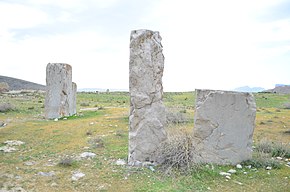Estaxr
|
Stakhr (Middle Persian) Estakhr (in Persian) |
|

Columns in Istakhr
|
|
| Region | Fars Province |
|---|---|
| Coordinates | 29°58′51″N 52°54′34″E / 29.98083°N 52.90944°ECoordinates: 29°58′51″N 52°54′34″E / 29.98083°N 52.90944°E |
| Type | Imperial City |
| History | |
| Founded | Achaemenid era |
| Periods | Classical antiquity to Late Middle Ages |
Stakhr (Middle Persian)
Istakhr (Middle Persian: Stakhr, Persian: اصطخر Estakhr) was an ancient city located in southern Iran, in Fars province, five kilometers north of Persepolis. It was a prosperous city under the Sasanian Empire and briefly served as its capital from 224 to 226 CE.
Istakhr first appears in history as an Achaemenid city. It gained its importance not only from its close association with Persepolis: it also commanded the western end of an ancient caravan-route that ran from the Indus Valley via Kandahar and Drangiana to Persia.
The city temporarily became the capital of the Sasanian Empire during the reign of Ardashir I (r. 224–242) before the capital was moved to Ctesiphon, in Mesopotamia. During the Sasanian period (224–651) the royal treasury of the empire, known as ganj ī šāhīgān, is said to have been in Istakhr. In 915–916, al-Masudi himself saw in a house at Istakhr owned by a Persian noble, "the large and very fine manuscript" of a work copied in 731 from original documents in the royal treasury.
The city was conquered by the Muslim Arab in 649CE. Two years later in 651 CE, the residents of Istakhr revolted. After the suppression of the revolt, 150,000 civilians were massacred in Istakhr by the victorious Arab forces as a reprisal for rebelling.
In 659 CE, caliph Ali sent Ziyad ibn Abi Sufyan to suppress a Persian rebellion in Istakhr. Ziyad succeeded at this and stayed on as governor. For a while, Abdallah ibn Mu'awiya (the designated leader of a Kaysanites Shia sub-sect) established himself at Istakhr from where he ruled for a few years over Fars and other parts of Persia, including Ahvaz, Jibal, Isfahan and Kerman from 744 to 748 until fleeing to Khurasan from the advancing Umayyad forces.
...
Wikipedia

